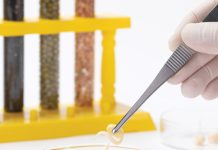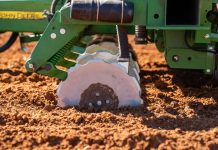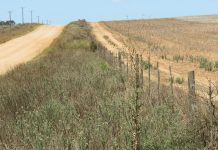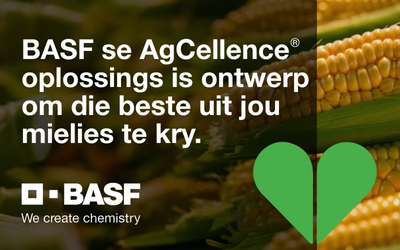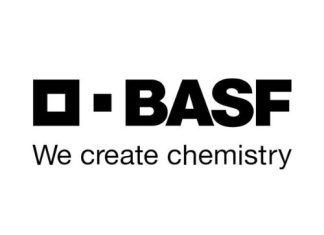
Dr Edzisani Nemadodzi, ARC-Grain Crops, Potchefstroom

Dr Hendrik Smith, ASSET Research

Phonnie du Toit,
ASSET Research

Liané Erasmus,
ASSET Research

Dr Dimakatso Ramphisa, North-West University
Improving crop production and productivity in the North West Province requires a sustainable cropping systems approach. This approach should include practices that improve and protect the soil’s health and its inherent capacity to provide plants with sufficient water and nutrients. Currently this is not being achieved.
Producers use mouldboard and disc (Photo 1) ploughs for soil cultivation which significantly increase the soil’s susceptibility to erosion. When these soils are removed through erosion, nutrients are also removed from the field. This could be through wind erosion when soil has been pulverised or through water erosion during periods of high rainfall. Additionally, the majority of producers apply less than the required amount of fertiliser as it is becoming more and more expensive.
Soil biological degradation is also one of the major constraints in the area, with soils very low in microbial and enzyme activity. Soil carbon is also low because of loss of organic carbon. Conventional tillage practices, whereby the soil is tilled several times between harvest of the previous crop and planting, destroy soil aggregates and accelerate organic matter mineralisation and soil degradation (Kan et al., 2020b).
Due to competing interests, producers remove plant residues from fields after harvesting to feed livestock. Soils are left bare and thus highly prone to evaporation, leading to moisture loss. This is supported by some authors such as Blanco-Canqui and Lal (2009), who reported that residue removal accelerates evaporation, increases fluctuations in soil temperature, and reduces input of organic matter needed to improve the soil’s ability to retain water. Erratic rainfall implies that an inadequate amount of rainfall is utilised by crops for maximum yield. The recent drought experienced in the 2023/2024 season is already an indication that current conventional production systems in the area are not sustainable.
Crop rotation is seldom applied with most producers growing sunflower and maize in monocropping systems. These have a high potential to aggravate nutrient imbalances in the soil as well as promoting soil-borne pathogens. According to Belete and Yadete (2023) continuous absorption of similar nutrients from the same soil root zones by the same crop is common in monocropping. Xiong et al. (2015) suggested that accumulations of microbial pathogens at the expense of plant-beneficial microorganisms in the soil are likely explanations for yield declines because of continuous monocropping.
Conservation agriculture (CA), as a system that embraces important principles and practices that can regenerate and protect degraded land due to decades of poor management, is proposed here to address ensuing challenges faced by producers.
CA emphasises working in harmony with nature and gives an advantage over other cropping systems in harnessing soil health. It employs minimum soil disturbance (Photo 2), permanent soil cover, and crop diversity through rotations. Integration of livestock and cover crops within the CA system can play an important role in regenerating soil health. Even though CA has been successfully implemented in fertile soils in some parts of the world such as southern America (Siziba, 2008), and in some pockets of commercial farms in South Africa, its performance on the degraded soils of semi-commercial farms in the North West Province of South Africa is not well known. This uncertainty provides a niche opportunity for researchers and farmers in these areas to explore prospects of reversing and stopping soil degradation through the adaptation of appropriate local CA systems.
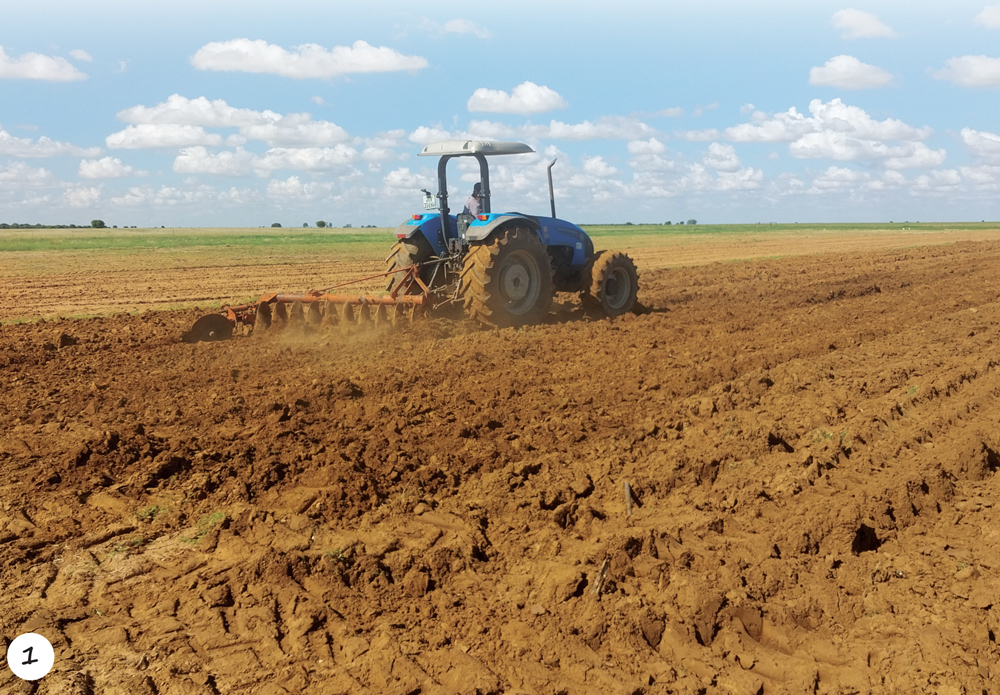
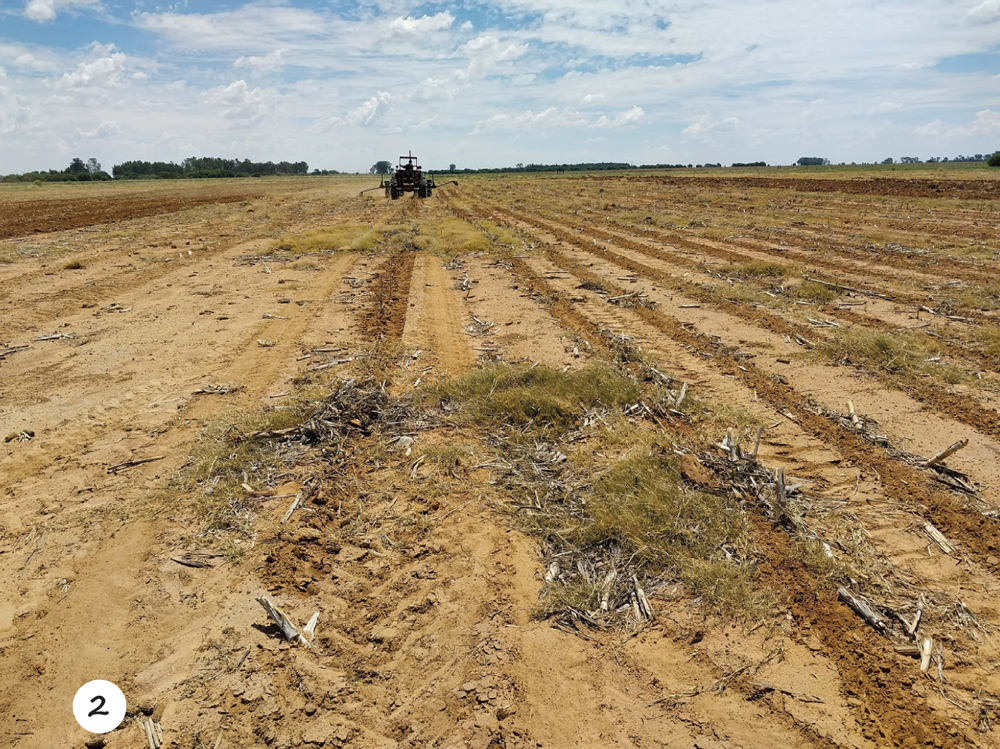
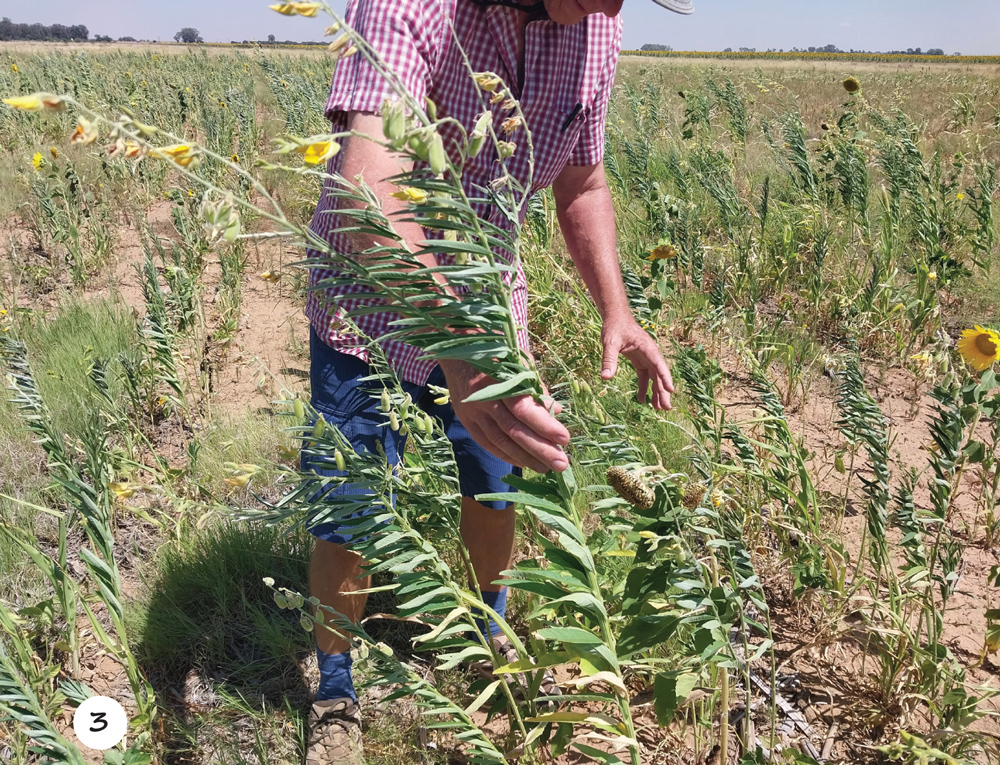
Method
There is an ongoing study at Weltevrede (Delareyville in the North West Province, Ngaka Modiri Molema District Municipality) to evaluate the effects of CA on selected soil chemical properties, selected soil enzymes, active carbon, organic carbon and microbial activity as well as yield of maize and sunflower. The trial was first established in the 2023/2024 season. The soil enzymes monitored were acid and alkaline phosphatase, glucosidase, and urease. The experiment included four treatments laid out in a randomised complete block design with three replicates. The treatments were: CT (conventional tillage): maize – sunflower (two-year conventional till rotation systems); NT (no-till): maize – sunflower rotation; CA1: maize + cover crop (intercropping) – sunflower + cover crop (intercropping); CA2: sunflower + cover crop (intercropping) – summer cover crop + winter cover crop (double cropping). The field was previously planted with sunflower in a conventional tillage system. The first soil samples as baseline were taken after the plots were demarcated (before trial establishment in 2023), while the second soil sampling was done during the growing period of the first season of trial establishment.
Maize cultivar VP8405BR, sunflower cultivar PAN7160CLP and a summer cover crop (SCC) mixture with grasses, legumes, and brassicas were planted. The SCC mixture consisted of sunflower, dolichos, Dr Saunders cow peas, sun hemp, sweet sorghum, stooling rye, mung beans, woolly pod and common vetch, linseed/flax, buckwheat, Japanese radish, pearl millet, babala, and black rape. The intercrop mixture consisted of Dr Saunders cow peas, bitter lupins, stooling rye, buckwheat, linseed/flax, mung beans, Japanese radish, chicory, white clover, and black rape. Weeds on CA plots were controlled using Roundup post-emergent herbicide both as pre-plant and as post-emergence application during the growing season. Prior to planting, lime was applied at 1 t/ha using a lime spreader to improve the soil pH status based on soil analysis results before the onset of the experiment. It is very important to address the pH status of the soil before starting with CA because the lime must be worked into the soil, which can be a problem in a no-till system. Fertiliser application was done based on fertiliser recommendations determined from a soil analysis report for all crops.
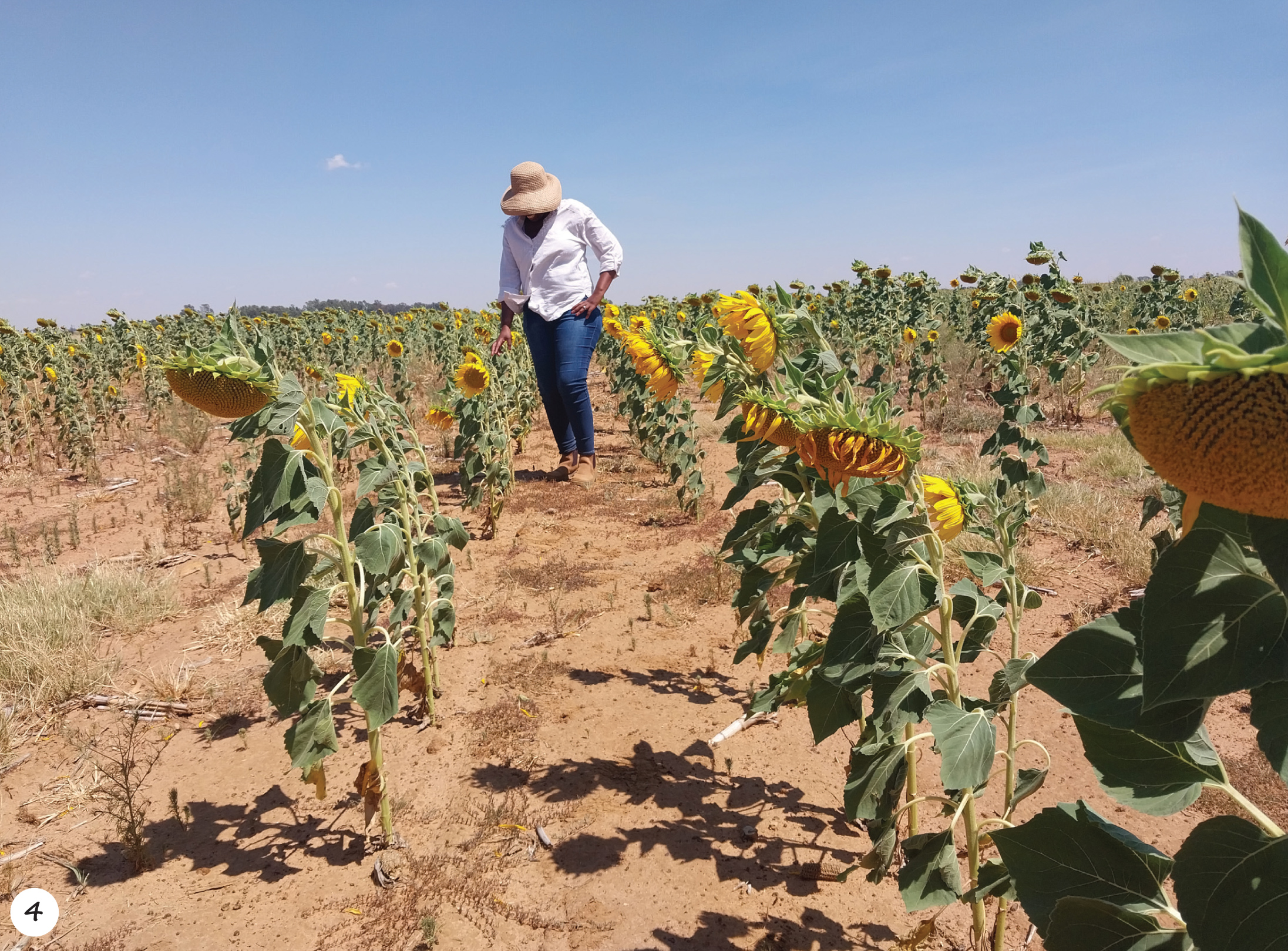
Results and discussions
Soil chemical properties
The analysis revealed that, except for Bray 1 phosphorus (P), none of the other measured chemical properties showed significant differences across the cropping systems. It was expected that these measured chemical properties may not show any significant variations, as cropping and tillage system effects on chemical soil properties are commonly reported to be absent in the first year of establishment (Moebius-Clune et al., 2008). The significant difference observed in Bray 1 P could have been due to significantly higher Bray P levels in the no-till maize system that was already present in the 2023 baseline soil testing, prior to the establishment of the experiment. Accordingly, this observation cannot be attributed to the effects of cropping systems tested in this study.
Further, the analysis revealed that soil electrical conductivity, pH, and Mehlich-3 phosphorus were the only parameters that remained relatively stable across the two sampling periods. All the other measured chemical properties differed significantly between sampling periods. The observed trend was for the concentration of exchangeable base cations (potassium (K), calcium (Ca), magnesium (Mg) and ammonium-N (NH4+-N), to be higher prior to crop establishment in 2023, with these levels declining during the 2023/2024 growing season.
In contrast, the phosphate-P (Bray 1), sulphate-S (SO4²-S), and nitrate-N (NO3–-N) levels were observed to be higher during the growing season in 2023/2024 compared to the baseline levels measured in 2023. This increase during the growing season could be attributed to mineralisation, fertiliser inputs, or enhanced microbial activity, which often accelerates nutrient availability. Increased microbial activity in soil samples collected during the growing season compared to samples collected prior to crop establishment supports this argument.
Soil biological properties
As expected, the cropping system had no significant effect on all the tested biological soil properties as it was too early for the soil to start regenerating after many years of a conventional cropping system. In contrast, soil enzyme activities, carbon dynamics, and microbial activity fluctuated significantly between the two sampling periods. Alkaline phosphatase, glucosidase, urease, active carbon, organic carbon, and microbial activity showed a significant temporal variation while acid phosphatase and organic carbon also demonstrated a significant effect of sampling time.
Microbial activity was higher during the growing season (2023/2024) compared to levels recorded in 2023, prior to crop establishment. While urease activity increased during the growing season, other enzymes (alkaline phosphatase, acid phosphatase, and glucosidase) were higher in 2023, before the experiment’s establishment, than during the growing season in 2024. A similar trend was observed for both active and organic carbon, with levels measured before crop establishment being higher compared to the growing season.
Maize and sunflower yield
The cropping system did not result in any significant differences in maize and sunflower yield. This could be due to several factors, including the dry season, it being the first season of trial establishment with no rotation introduced yet, and lack of build-up of crop cover from residues.
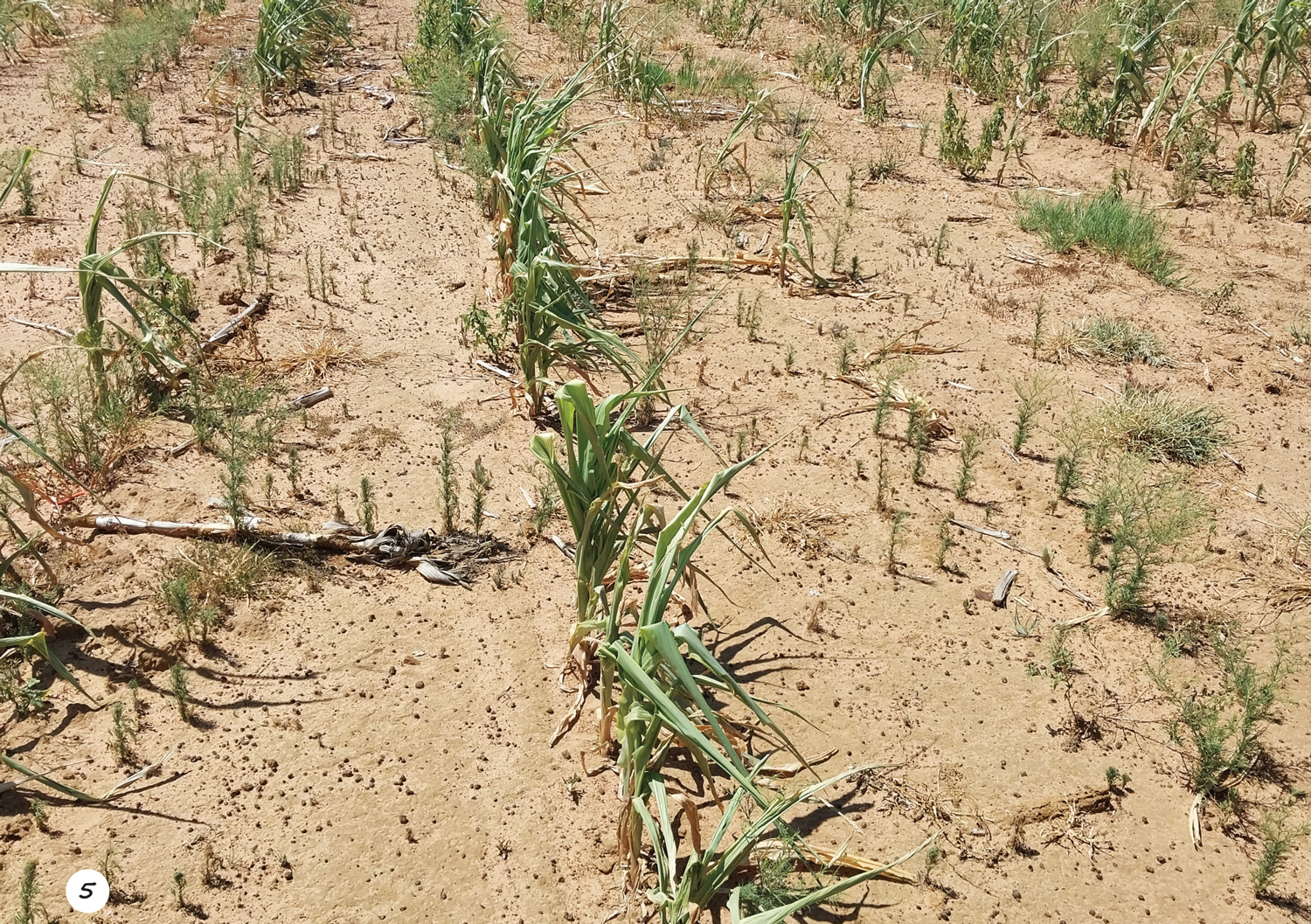
Conclusion
While no conclusive results can be given at this stage (first planting season of the experiment), some important observations were made. The season was characterised by very high temperatures and very low and late rainfall. Despite this prolonged dry spell, sunflower showed more resilience than maize with most of the sunflower plants having reached grain physiological maturity stage across treatments. However, maize was severely affected by the drought with the majority of plants stunted and wilting with no cobs formed. These preliminary results suggest the benefits of CA can only be realised after several seasons. A dry season produces a low yield with low crop residues. Accumulation of proper residues of at least 30% can only be realised when the plant growth is higher and over several seasons, which is not yet the case in this study. Good plant residue can improve moisture availability during seasons of low rainfall. It can accordingly be argued that moisture serves as the catalyst for soil functionality.
For further information, contact Dr Edzisani Nemadodzi at nemadodzie@arc.agric.za or 018 299 6100.
References
- Belete, T and Yadete E. 2023. Effect of Mono Cropping on Soil Health and Fertility Management for Sustainable Agriculture Practices: A Review. Journal of Plant Sciences, 11(6), 192 – 197.
- Hobbs, PR, Sayre, K and Gupta, R. 2007. The role of conservation agriculture in sustainable agriculture. Philosophical Transactions of the Royal Society B, 353:543 – 555.
- Kan, ZR, Virk, AL, Wu, G, Qi, JY, Ma, ST, Wang, X, Zhao, X, Lal, R and Zhang, HL. 2020b. Priming effect intensity of soil organic carbon mineralization under no-till and residue retention. Applied Soil Ecology, 147, 103445.
- Landtipe-opnamepersoneel. 1984. Landtipes van die kaarte 2526 Rustenburg, 2528 Pretoria. Mem. Nat. Landbouhulpbr. S. Afr. Nr. 8.
- Moebius-Clune, B, Van Es, HM, Idowu, OJ, Schindlebeck, RR, Moebius-Clune, D, Wolfe, DD and Siziba, S. 2008. Assessing the adoption of conservation agriculture in Zimbabwe’s smallholder sector. PhD Thesis. Stuttgart, Germany: University of Hohenheim.
- Xiong, W, Zhao, Q, Zhao, J, Xun, W, Li, R, Zhang, R, Wu, H and Shen, Q. 2015. Different continuous cropping spans significantly affect microbial community membership and structure in a vanilla-grown soil as revealed by deep pyrosequencing. Microbial Ecology, 70(1), 209 – 218.





